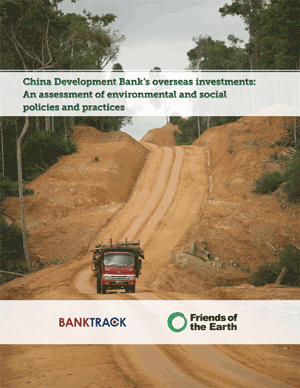- Blog
- Climate & Energy Justice
- New report on China Development Bank shows the bank lagging behind its peers
New report on China Development Bank shows the bank lagging behind its peers

Donate Now!
Your contribution will benefit Friends of the Earth.
Stay Informed
Thanks for your interest in Friends of the Earth. You can find information about us and get in touch the following ways:
Over the past several years, Chinese overseas investments have had a powerful global impact, from the Gibe 3 dam in Ethiopia, to the Alberta tar sands in Canada, to the Shwe oil and gas project in Myanmar. In the past, many of these environmentally and socially controversial mega-projects were bankrolled by development institutions such as the World Bank, national export credit agencies, or big Wall Street banks. But increasingly, Chinese banks have been funding these projects, and it has not escaped the notice of governments, business, civil society, and of course, communities on the ground.
In particular, this trend has created significant concern among those advocates who, for years, have promoted the adoption of strong environmental and social financing standards. For example, today the World Bank environmental and social safeguard policies, the OECD Common Approaches on the Environment, and the Equator Principles for project finance help form a set of international financing norms that provide some measure of protection for the environment and communities. (The implementation of these norms, of course, are a different story; advocates are constantly trying to hold institutions accountable for complying with them.) Chinese banks, even though they are becoming major players in international development finance, have not tended to abide by these standards.
One of China’s largest overseas financiers is the China Development Bank. With almost USD 1 trillion in assets, CDB is the largest development bank in the world. Today, Friends of the Earth-U.S. and BankTrack released a report, China Development Bank’s overseas investments: An assessment of environmental and social policies and practices, that describes how the bank raises and disburses capital, how it is governed, and what its overseas financing portfolio looks like.
As one might guess, CDB is a major financier of natural resource and infrastructure projects abroad. The report dives into four examples of CDB’s overseas transactions: the Alberta tar sands, the Shwe oil and gas project in Burma, Reliance Power’s ultra mega coal power plants in India, and Asia Pulp and Paper’s notorious logging activities in Indonesia. As evidenced by these ‘Dodgy Deals,’ CDB’s portfolio is as full of environmentally and socially risky projects as any of its international peers. But critically, CDB’s environmental and social policies fall short compared to its competitors.
However, a new China Banking Regulatory Commission Directive offers some hope. A few years ago, the CBRC launched an impressive new policy, the Green Credit Policy, which essentially requires Chinese banks to ensure that large, environmentally risky projects are in compliance with environmental laws before the banks lend them money. The policy was the first of its kind in the world, but it was really oriented towards ensuring that projects in China were compliance with Chinese law. But in February 2012, the CBRC issued a new Directive to the Green Credit Policy, which specifically instructs Chinese banks to adhere to international environmental and social financing standards in overseas transactions.
The new Directive provides an opportunity for communities around the world affected by Chinese bank-financed deals — such as the massive Rio Blano mine in Peru or the Merowe dam in Sudan — with a leverage point to stop or improve an environmentally and socially sensitive project.
The Directive also offers sustainable finance advocates both in China and internationally a chance to promote the implementation of this pioneering new banking regulation, and to work with a new group of globally important banks.
Finally, it allows those promoting international social, environmental and financial norms — such as the Extractive Industries Transparency Initiative on revenue transparency, the Equator Principles for project finance, and the UN Declaration on the Rights of Indigenous Peoples — to enlist the participation of powerful Chinese players that have been generally absent from these initiatives.
We hope that this new report on China Development Bank assists all these groups: communities, sustainable finance promoters, and environmental and human rights advocates. In particular, we hope it helps civil society organizations and other advocates support the CDB in fully applying the new Green Credit Policy Directive, and in improving the quality and implementation of the bank’s own environmental and social financing standards. As we note in the report, while the bank funds a lot of environmentally harmful activities, it also is a leading financier of ecologically restorative projects too. The opportunity to redirect the bulk of CDB’s financing towards truly sustainable ends is not only great for China, but for the planet as well.
